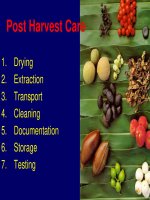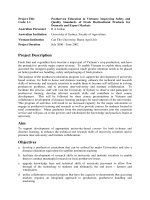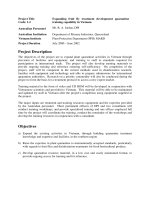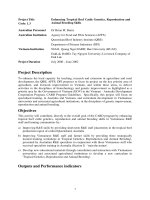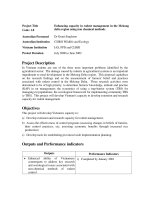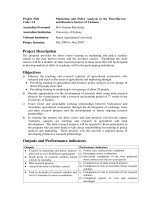Báo cáo nghiên cứu nông nghiệp " Terms Commonly Used in Tree Improvement " doc
Bạn đang xem bản rút gọn của tài liệu. Xem và tải ngay bản đầy đủ của tài liệu tại đây (1.01 MB, 18 trang )
Terms Commonly
Used in Tree Improvement
Khongsak Pinyopusarerk
CSIRO/Ensis-Genetics
Canberra, Australia
Population
• A community of interbreeding individuals.
No degree of relationship is assumed.
• The term “Stand” is often used
synonymously.
Provenance
• Geographic location
where seed was
collected.
• Refers to natural
forests, not
plantations.
• Provenance
boundaries not
always clear-cut,
often one of judgment
and opinion.
• Provenance may
have different genetic
adaptation.
130° 140°
10°
20°
0500
Kilometres
32
31
30
29
28
27
25
26
1
6
1
9
22
15
24
23
21
17
18
14
13
1-12
20
WA NT QLD
Land race
• Introduced trees that are adapted to an
environment after several generations
• Advantage
Natural selection helps land races adapt to a new
environment
• Disadvantage
May not be from the best natural provenances or come
from very small genetic base
Family
• Individuals with parents in common
• Half-sib family
One common mother, father unknown
• Full-sib family
Both parents in common
Generated by artificial (controlled) pollination
Progeny
• Trees produced from the seed of a known
parent.
• Progeny tests are established to determine the
genetic worth of the parent trees.
• Testing of vegetative propagules (e.g. grafted or
cutting materials) is also a progeny test, but
often called “clonal test”.
Genotype
• The genetic potential of the tree when
environmental factors are excluded, i.e.
only determined by the genes of the tree.
• Genotype is determined chiefly from
performance of progeny and other
relatives.
Phenotype
• The tree as we see it.
• Phenotype is determined by the genotype (G)
plus the environment (E).
P = G x E
• Similar phenotypes do not necessary breed
alike.
In natural stand phenotype is influenced by the
environment in which the trees are growing.
When growing in plantations and under similar
environmental conditions, superior phenotypes tend to
have good genetic potential.
Genetically identical individual trees (ramets) produced by
vegetative propagation from founder tree (ortet).
Ortet
(superior tree
in field trial)
Ramets
Vegetative propagation
(Cuttings, grafts, or
micropropagation)
One clone
Clone
Clone
These trees were propagated by cuttings.
Ortet
The original
plant from
which a clone
has been
derived.
Ramet
An individual
member of a
clone.
In breeding
• Production of offspring by
mating between closely
related trees, usually by.
Selfing.
• This procedure if carried
out for a number of
generations will expose
undesirable, recessive
characters.
Outcrossing
• Production of offspring by mating between
unrelated trees or distantly related trees.
Roguing
• Systematic removal of undesirable
individuals from a population
• Synonym with “culling”
Heritability (h
2
)
• Measure of proportion of variation due to
genetics (ranges from 0 to 1)
• Apply only to a particular population
growing in a particular environment
• Usually within an expected range
Growth: h
2
= 0.15 – 0.25 (moderate)
Wood density: h
2
= 0.40 – 0.60 (high)
Branching : h
2
= 0.05 – 0.10 (low)


